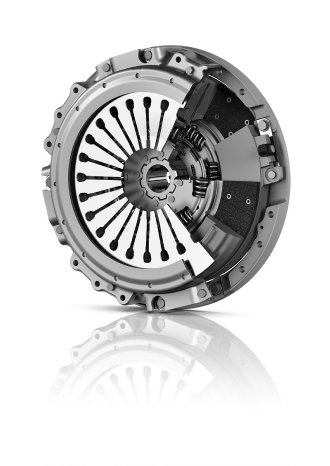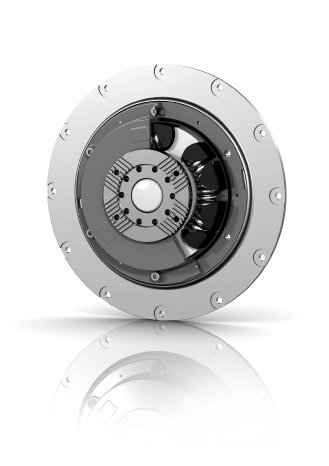- Power take-off clutches for special applications
- Dual clutches as drive for auxiliary devices
- Clutch discs for highest demands
- Twin-disc clutches for heavy loads
- Various torsional dampers for all requirements
Power take-off clutches
If a permanent power take-off (PTO) is required for special applications, e.g. in concrete pumps or sewer cleaning vehicles, it can be propelled by a driving disc that is firmly connected to the clutch cover housing. The PTO then always runs at engine speed. The driving disc can be optionally equipped with or without torsional damper. (Fig 8)
Dual clutches
These are two clutches combined in one unit that do separate jobs. They are used in vehicles that have auxiliary devices which have to be activated and deactivated separately. A central Belleville spring provides the clamping force for both systems.
On the DuT-type dual clutch, the drive and PTO clutch are activated by separately acting releasers and release lever sets.
On the DoT-type dual clutch, the two clutch systems are activated by a common releaser and release lever set in two successive stages.
Clutch discs
All the components of construction and agricultural machines feature especially robust dimensions due to the high loads they are subject to. Intermediate springs are used as cushion springs. They are directly connected to the driver plate and are therefore especially robust. For applications with high thermal loads, the clutch disc can be equipped with cerametallic facings.
For applications that place high demands on noise comfort, the clutch discs can feature a torsional damper and if necessary also a predamper for idling mode.
Twin-disc clutches
Heavy-duty vehicles, difficult terrain, heavy loads - extreme demands are placed on the clutch here, especially because starting on extreme inclines and frequent maneuvering are often part of the normal routine in this area. Long clutch friction times generate heat, which can increase wear on the facings to a disproportionate degree. For this reason, especially commercial vehicles in construction site application, heavy traction machines and special vehicles require a highly robust clutch. For these applications, the twin-disc clutch offers the optimum solution. The twin-disc clutch saves time-consuming and costly clutch replacements and avoids downtimes, thereby making an essential contribution to increased efficiency. (Fig 9)
Thanks to its modular system, the twin-disc clutch can be perfectly adapted to most different applications. ZF offers both economically interesting versions with sheet-metal housing, as well as cast housing versions for applications with high thermal load.
Torsional dampers
Torsional dampers are always installed behind the engine as vibrational dampers when the powertrain does not have a separating and moving-off clutch.
The purpose of torsional dampers is to prevent the powertrain and/or coupled auxiliary units from engine torque peaks as well as operational irregularities. All commercial vehicles with powershift transmission or hydrostatic drive feature a torsional damper these days, which – to put it simply – ensures “peace and quietness” in the vehicle. If the operative forces in the powertrain are not countered, driving comfort is noticeably impaired and the powertrain components show considerably greater wear.
A bolt-on torsional damper is the standard solution these days for decoupling torsional vibrations. It is based on the technology used in a torsionally damped clutch disc.
For applications with higher demands, the DynaDamp from ZF provides the answer. DynaDamp uses the same technology as the established dual-mass flywheel in order to decouple torsional vibrations reliably and with a high degree of effectiveness.
ZF puts its experience gained from large-scale series technology into all of its torsional dampers. This means that its products developed for special applications feature the same quality as those for large-scale series. (Fig 10)



